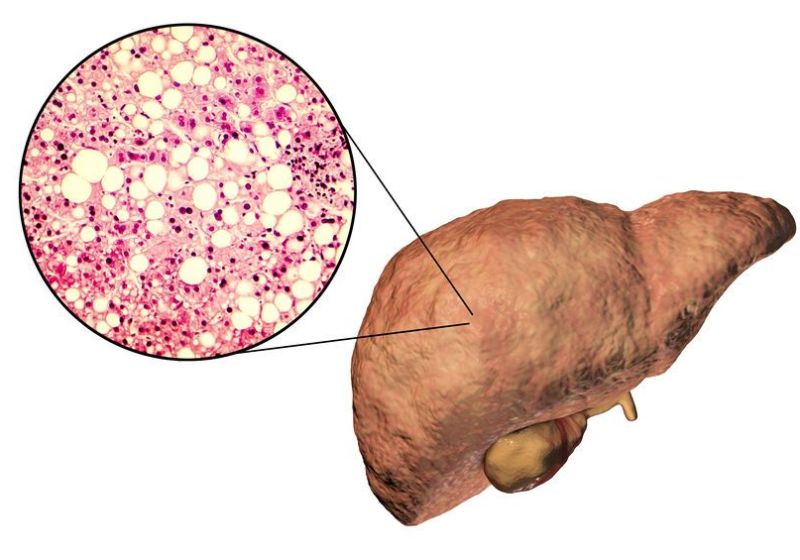Fatty Liver Disease
What is fatty liver disease?
Fatty liver disease is becoming increasingly common worldwide, particularly in Western nations. It is the most common form of chronic liver disease in the United States and affects an estimated 80 to 100 million people.
Fatty liver disease occurs in all age groups, but particularly in people in their 40s and 50s who are at high risk for heart disease due to risk factors such as obesity and type 2 diabetes. Abnormalities include increased abdominal fat, a lack of ability to use hormone insulin, high blood pressure, and high blood levels of triglycerides are all linked to this condition.
Symptoms
There are usually no signs and symptoms of fatty liver disease. But if signs do occur some of the symptoms include:
- Enlarged liver
- Fatigue
- Pain in the upper right abdomen

Causes
Experts don’t really know why some people accumulate fat in the liver while others do not. The understanding of why some fatty livers develop inflammation that eventually leads to cirrhosis is limited.
The following is linked to fatty liver disease:
- Overweight or obesity
- Insulin resistance in which your cells do not absorb sugar in response to the insulin hormone
- High blood sugar, indicating pre-diabetes or actual type 2 diabetes
- High levels of fats, particularly triglycerides, in the blood
These combined health issues seem to encourage the deposition of fat in the liver. For certain people, this excess fat acts as a chemical to liver cells, causing inflammation of the liver and non-alcoholic steatohepatitis, which can lead to scar tissue buildup in the liver.
Risk factors
Some of the risk factors that come with fatty liver disease include:
- High cholesterol
- High levels of triglycerides in the blood
- Metabolic syndrome
- Obesity, particularly when fat is concentrated in the abdomen
- Polycystic ovary syndrome
- Sleep apnea
- Type 2 diabetes
- Under active thyroid
- Under active pituitary gland
Nonalcoholic steatohepatitis is more likely in these groups:
- Older people
- People with diabetes
- People with body fat concentrated in the abdomen
Without further testing, non-alcoholic fatty liver disease is difficult to distinguish from non-alcoholic steatohepatitis.
Complications
Cirrhosis, which is late-stage scarring in the liver, is the major complication of nonalcoholic fatty liver disease and nonalcoholic steatohepatitis. Cirrhosis occurs as a response to liver injury, such as in non-alcoholic steatohepatitis inflammation. As the liver attempts to stop inflammation, scarring areas are produced. Fibrosis spreads to absorb more and more liver tissue with continued inflammation.
If the process isn’t interrupted, cirrhosis can lead to:
- Fluid buildup in the abdomen (ascites)
- Swelling of veins in your esophagus (esophageal varices), which can rupture and bleed
- Confusion, drowsiness and slurred speech (hepatic encephalopathy)
- Liver cancer
- End-stage liver failure, which means the liver has stopped functioning
Approximately 20 percent of people with non-alcoholic steatohepatitis will advance to cirrhosis.
Treatment options for fatty liver disease
The first treatment line is usually a loss of weight by a combination of a healthy diet and exercise. Losing weight deals with the conditions contributing to fatty liver disease. Ideally it is desirable to lose 10 per cent body weight, but risk factors may be improved if you even lose 3-5 per cent of your initial weight. Even for those who have to lose much weight, weight-loss surgery is an option.
Your doctor may recommend hepatitis A and hepatitis B vaccinations to help protect you against viruses that can further harm your liver damage.
Liver transplantation may be an option for people with cirrhosis due to non-alcoholic steatohepatitis. Liver transplantation results are generally very good in this population group.
Prevention
To reduce your risk of nonalcoholic fatty liver disease:
- Choosing a healthy diet. Choose a healthy plant-based diet rich in fruits, vegetables, whole grains and healthy fats.
- Maintaining a healthy weight. If you’re overweight or obese, reduce the number of calories you eat each day and get more exercise. If you have a healthy body weight, work on maintaining it by choosing a healthy diet and exercising.
- Exercise as often as possible. If you have not been exercising make sure to get an OK from your doctor first.
We Welcome You!
If you have any further questions concerning your liver please call us today and schedule an appointment with one of our trained professionals.
